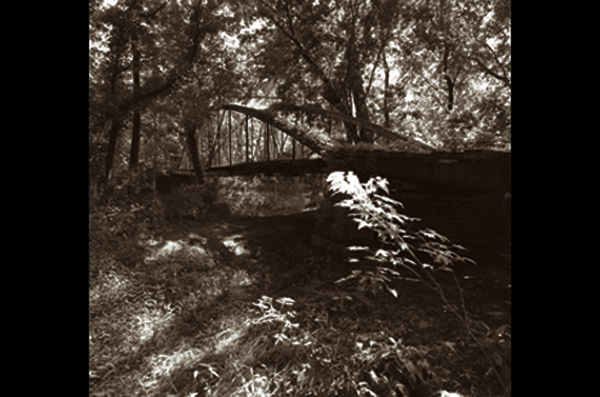
FAYETTEVILLE, Ark. – May is Arkansas Heritage Month, and the 2010 theme is “Roads Less Traveled: The Enduring Heritage of Rural Arkansas.” To celebrate, an exhibit of photographs by Maxine Payne titled “God Willin’ and the Creek Don’t Rise: Arkansas Historic Bridges” is currently on display in Mullins Library on the University of Arkansas campus.
There are things about bridges that capture the imagination. Perhaps they are the possibilities opened by spanning obstacles, or the hopes inspired by reaching new places. The completions of new bridges were often celebrated achievements in Arkansas communities, both large and small. Payne’s exhibit emphasizes the historic nature of the enduring bridges in Arkansas, with each image also containing factual information about the bridge depicted, including details of its construction, design, historical status and location. In short, the exhibit can teach the viewer an awful lot about both bridges and rural Arkansas roadways.
For instance, the viewer learns that the oldest bridge remaining in Arkansas is the Springfield Des Arc Bridge, constructed by the King Bridge Manufactory and Iron Works in 1874. It is also identified as the only remaining “iron bowstring arch steel pony truss bridge” in the state. The viewer might require a bridge primer to discover that “bowstring arch” describes the structure of the bridge, in which an arch diverts the outward thrust to linked ends resting on a pylon or platform, and a “pony truss” describes the type of decking for the bridge, in which traffic travels between parallel superstructures that are not cross-braced at the top, in this case, the arches themselves. The Springfield Des Arc Bridge is a simple feat of engineering that remains elegant in its design, a point that Payne captures in her photograph.
The Fryer’s Ford Bridge is 16 years younger than the Springfield Des Arch Bridge, having been built in 1890 by the Wrought Iron Bridge Co. of Canton, Ohio, one of the largest producers of truss bridges in the United States at that time. Fryer’s Ford Bridge is the oldest bridge still in service in Arkansas, spanning the east fork of Point Remove Creek on Conway County Road 67. The bridge is identified as a “wrought iron Pratt through truss bridge,” meaning the vertical structural members are paired with diagonal structural members that slope down toward the center, and that the truss members are both above and below the roadbed.
The Sylamore Suspension Bridge is a more recognizable type of bridge to most viewers familiar with famous suspension bridges such as the Golden Gate Bridge in San Francisco and the George Washington Bridge in New York City. A suspension bridge is a type of bridge in which horizontal cables suspended between towers provide structural support and vertical suspender cables carry the weight of the deck. The Sylamore Suspension Bridge was built in 1943 by the Arkansas State Highway and Transportation Department on Stone County Road 283, and is one of two such bridges still in service in the state.
Though not unique in the state, the Mulladay Hollow Bridge is certainly appealing to viewers, featuring a design that has proved to last for thousands of years, when constructed under the capable direction of the Roman Empire. The two span masonry arch bridge was constructed by the Civilian Conservation Corp in 1935 as part of the Leatherwood Lake Recreation Project west of Eureka Springs and features an elegant curve on its west end.
Photographing historic bridges for the Arkansas Highway and Transportation Department is certainly a massive project, but Maxine Payne, who says she “works to find ways to engage community in her work,” has successfully made images of Arkansas historic bridges edifying to the viewer.
Maxine Payne is a photographer living and working in Arkansas, where her grandparents raised her. She received her Master of Fine Arts from the University of Iowa, where she was also an Iowa Arts Fellow. Payne was selected a Fellow of the American Photography Institute at New York University, as well as a Fellow of the College Art Association. Currently, Payne is an associate professor of art and departmental chair at Hendrix College in Conway, Ark.
“God Willin’ and the Creek Don’t Rise: Arkansas Historic Bridges” will be on display in the Mullins Library lobby level through the end of June. To see additional images, visit the University Libraries’ exhibit Web site or for more information, call 479-575-2962.